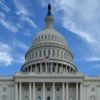Colorado Parent Advocacy Network (CPAN), a conservative parents’ rights group, hosted a school safety summit this past weekend at St. Thomas More Catholic Parish in Englewood, asking for members to advocate for armed security teams, including teachers and staff, at their schools.
“Today is laser-focused on one thing,’ said moderator Deborah Flora, conservative radio show host and CPAN board member, “and that is how we protect our schools and the educators and students in them.”
Looking at the audience, Flora said, “So my school board warriors, this [armed security teams] is one of the topics we can bring up and look at school budgets and begin with this as a first line of defense.”
Flora said conversations around stopping school shootings tend to get lost in “larger cultural and political issues” and that these arguments prevent the public from hearing the whole story. For instance, she said armed security teams act as a deterrent and that 94% of these mass shootings happen in areas where no one is armed (gun-free zones).
Her claim comes from a study by gun rights advocacy group the Crime Prevention Research Center, yet, the Associated Press reported that this data is flawed. According to Daniel Webster, a scholar at Johns Hopkins University’s Center for Gun Violence Solutions in Baltimore, Maryland, “Looking at gun violence data from 1950 to 1990 is ‘irrelevant’ because many states banned or heavily restricted concealed firearms during that period, making almost any public mass shooting during those years as having taken place in a gun-free zone.”
A 2021 study sponsored by the National Institute of Justice found no association between having an armed officer and deterrence of violence in cases where more than one person was intentionally shot in a school building during a school day or a person arrived at school with the intent of firing indiscriminately (133 total cases) from 1980 to 2019.
Rather, the study found that an “armed officer on the scene was the number one factor associated with increased casualties after the perpetrators’ use of assault rifles or submachine guns and that whenever firearms are present, there is room for error, and even highly trained officers get split-second decisions wrong.”
Panel members include gun rights advocates
Panel members included Jimmy Graham, who continues to deny his firearms training company, Able Shepard, organized a protest against a drag show at Douglas County PrideFest, Laura Carno, executive director of FASTER (Faculty/Administrator Safety Training and Emergency Response) Colorado, Ann Moore, a retired Dean of Students for Cherry Creek Schools, and Brett Titus, CEO of LifeSpot, an active threat mitigation app.

Graham and Carno stand to gain financially should more districts allow armed teachers and staff. Moore is the executive director for the Center for Cowboy Ethics and Leadership, whose mission is to “bring the simple, timeless values embodied in the Code of the West back to the fore of American life.” Titus is a former Denver Police officer whose app is designed to speed crisis response times.
Colorado law allows teachers and staff to carry a concealed handgun with school board approval. Carno said 45 districts had undergone her training. Those districts are mostly rural, where law enforcement can take 30 to 60 minutes to respond, but Carno wants to see more urban and suburban school districts go through her program.
Carno argued that even though it took only 45 to 50 seconds for an armed school resource officer at Arapahoe High School to respond when a shooter entered the building and killed Claire Davis, he wasn’t fast enough. FASTER began as a project of the Independence Institute, a Denver-based libertarian think tank that supports gun rights, among other conservative causes.
Carno and Graham claim their training is more rigid than what police officers have to go through. However, one study found that “even highly trained law enforcement see their ability to shoot accurately in ‘split-second’ situations decreases significantly.”
The other half of the panel included STEM school shooting survivor Brendan Bialy, Columbine shooting survivor Evan Todd, Seattle Pacific University shooting survivor Daniel Fenlason, and John Castillo, whose son Kendrick died in effort to stop the STEM school shooter.
For survivors, including grief-stricken parents, the debate is nuanced. It’s possible that if Kendrick’s teacher had been armed, his murderer might have been prevented from shooting. For them, there’s no safe cushion of time between when someone starts shooting and when law enforcement arrives.
National survey finds majority of teachers believe guns in schools make them less safe
According to a representative survey from the RAND Corporation released this May, 54% of a nationally representative sample of teachers reported believing that teachers carrying firearms will make schools less safe, 20% believed it would make schools safer. The final 26% reported feeling that it would make schools neither more nor less safe.
Of those likely to support teacher-carry policies, the majority are male, affiliated with the Republican party, teach in rural schools, and have a personal interest in carrying firearms.
The survey also found “that while school shootings are an extreme form of school violence and often drive the policy debate around school safety, only 5 percent of teachers selected this as the most significant safety concern at their school.”
Roughly half of all teachers (49 percent) said bullying and cyberbullying are their top safety concerns.




